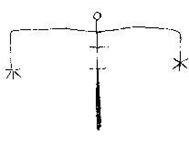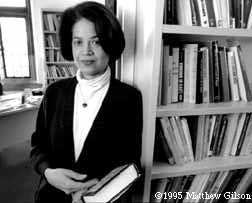
Privatizer: Robert Vishny helped over 14,000 Russian businesses change hands.
 The University of Chicago Magazine April 1995
The University of Chicago Magazine April 1995

Privatizer: Robert Vishny helped over 14,000 Russian businesses change hands.
Between 1992 and 1994, two-thirds of Russia's industrial workforce left the public payrolls for the private sector-without even changing jobs. Through privatization, the companies themselves went from state-owned assets to private corporations, each with a board, corporate charter, and tradable stock. In just 22 months, the remarkable reform program auctioned newly created shares in over 14,000 companies, exchanging the shares for inexpensive vouchers offered to all 147 million Russian citizens. In the new federation's struggle to remake its communist economy, privatization became that rarest of things: a successful government program. One poll showed more than 60 percent of Russians supporting it-in 1994, the song "Wow, Wow, Voucher!" even rose to number five on the country's hit parade.
Privatization, which concluded in July 1994, has proven an economic boon, says Robert Vishny, a young Chicago economist who is one of the program's architects. Yet most Western experts and Russian reformers, he says, originally ranked other reforms as higher priorities: ending centralized price controls-which Yeltsin's government did within months of gaining power in November 1991-and stabilizing the money sup-ply, where growth in the face of budget deficits helped fuel runaway inflation.
Despite reformers' ongoing troubles with fiscal policy-and with antireformers in Parliament-privatization began early and finished quickly, allowing new private companies to start changing themselves into profitable enterprises. Vishny, an expert in corporate finance and the Eric J. Gleacher professor at the Graduate School of Business, became involved in privatization through the connections of his frequent research partner Andrei Shleifer, a Russian émigré currently at Harvard Business School and formerly at the GSB. They worked with economist Maxim Boycko and lawyer Jonathan Hay, both from Russia's privatization ministry.
The Western-trained team, says Vishny, shared the philosophy that privatization couldn't wait. Above all, they saw political influence as the Russian economy's basic problem. Foreign investment-a strategy suggested by some experts-would help little, they argued, as long as government ministries determined companies' products, access to capital and subsidies, and employment and output levels. Freeing a company from such control, says Vishny, tells its manager, "You're now the owner of this thing, and if you can manage to produce a good product at a profit, you can keep it."
But would Russian managers take up the challenge? As Vishny, Boycko, and Shleifer recount in Privatizing Russia, published this month by MIT Press, their team felt certain that Russians, "like the rest of the people in the world, were `economic men' who re-sponded rationally to incentives." Indeed, a survey that Boycko helped conduct showed that Americans and Russians hold very similar views of private property and markets.
Vishny and company decided the trick was to balance the central government's interests with those of employees, managers, and local government. (Companies involved with defense, natural resources, or health care, for example, were prohibited from privatizing.) A giant sell-off to outside investors would raise cash but anger the Russian populace. Giving companies away to employees and managers would be popular but would risk repeating the economic disaster of Russia's collective farms.
At first, experts with other privatization schemes vied for the ear of Anatoly Chubais, appointed to lead the new privatization ministry in late 1991. But by early 1992, the free-market arguments of Vishny's team won out. They credit Chubais's political skills-aided by the Parliament's initially weak opposition-with the program's quick start.
Making regular trips to Russia, Vishny and the other advisers drafted privatization regulations, while the reform politicians, he says, were the "big-picture thinkers," fitting policy into political reality. Parliament passed most of the plan in early 1992 but soon dug in its heels against further reform. So the president, recalls Vishny, used other avenues to finish the job: "Sometimes we would write something, and Yeltsin would issue it as a decree." By mid-1993, when antireformers launched a new bid to end privatization, the policy was already too popular to stop.
The key, explains Vishny, was the voucher, which had a face value of 10,000 rubles and cost only 25 rubles (10 cents). Privatization gave or sold a fraction of each company's stock to its managers and employees and specified that 29 percent of all stock be auctioned, through vouchers, to the general public. Ninety-eight percent of Russians purchased a voucher, and Russian television heavily advertised the new program. "Once you've thrown the voucher out there," says Vishny, "the prospect of not having any companies for people to bid for is politically unpalatable."
Another popular feature: Vouchers could be swapped for cash, stock, or shares in hundreds of new voucher-investment funds, which function like American mutual funds. Entrepreneurs began trading vouchers both door-to-door and at commodity exchanges. There, large investors could buy enough vouchers to acquire sizable percentages of desirable companies, where, Vishny says, they've become essential voices for change at the corporate level.
Such corporate restructuring is the next step in reform, he says. Profitability may mean "changing the product profile, investing in some equipment, starting to advertise, or paying a little more attention to what the consumer wants." Subsidies, however, still allow the government to control some private firms. Companies may be paid to pad their workforce-often because they, not local government, supply services such as health care-and ignore the profits of greater efficiency. "If the subsidies are flowing too readily," warns Vishny, "the incentives provided by private ownership won't be sufficient."
The solution, he says, is to discontinue such credits, shift social services to local governments, and lessen corruption and crime. All reforms, though, are threatened by political instability-unrest in Chechnya and other areas, fights between the president and Parliament, and resentment among pensioners, whose fixed incomes have been whittled away by inflation. Their plight, says Vishny, is a political opportunity for ex-communists or fascists.
For the moment, he says, the economic situation continues to show "a lot of positive signs. There's construction, people are building homes, and the products in the stores are better." Fiscal policy, too, has become more responsible, lowering inflation. News reporters in the West, he observes, "don't really appreciate the extent to which the markets are working." Moreover, "you now have powerful interest groups interested in getting the government out of economic activity." Thanks to privatization, 40 million Russians now own stock-a force for reform, he notes, lacking in Eastern European economies that took a slow approach to change.
Vishny and Shleifer are still studying privatization-now in the United States. With data on 3,000 U.S. counties, they're looking for factors that predict when municipal services are farmed out to private contractors. So far they've found two: Politicians privatize when under budget pressure and when the patronage benefits from job appointments are minimal. Market incentives, apparently, aren't the only point in common between Russia and America.-A.C.
 Click here for larger image.
Click here for larger image.
In January 1778, sailing from Tahiti on a search for the Northwest Passage, Captain James Cook's two ships made the first European contact with the Hawaiian islands. To the Hawaiians, though, Cook was no ordinary sea captain: A series of coincidences between his arrival and their own religious traditions led to the belief that Cook was a form of Lono, a deity celebrated in the New Year's festival during which he arrived. In a return visit, on the shores of Hawai'i Island, the same belief contributed to Cook's death, and the Cook-Lono connection has been a staple of Hawaiian history ever since.
But did the Hawaiians really see Cook as a god, as Chicago anthropologist Marshall Sahlins and others have maintained? Or is that explanation merely the ethnocentric invention of Westerners, ascribing to Hawaiians a notion that the native people were, in fact, far too rational to believe?
Gananath Obeyesekere presented this alternative in his award-winning 1992 book, The Apotheosis of Captain Cook: European Mythmaking in the Pacific. Obeyesekere, a Princeton anthropologist, argued that Lono was simply a name that Hawaiians gave Cook, a mortal with the status of a chief. Obeyesekere also challenged another "myth": The famous British navigator was not an enlightened explorer but, during his final voyage, a man of violence akin to Cortés and the conquistadors.
If Captain Cook embodied the dark side of Western imperialism, wrote Obeyesekere, his accomplices-at least in their symbolic destruction of Hawaiian culture-are his modern-day interpreters, a group headed by Oceania scholar Sahlins, chair of anthropology at Chicago.
Indeed, Obeyesekere aimed much of his criticism at Sahlins' 1980s research on Cook. That work, he said, depended on "uncritical readings" of historical texts-including some of "blatant unreliability"-and inaccurate and misleading use of quotations. The result, claimed the Sri Lankan scholar: Rather than illuminating the Hawaiians' experience, Sahlins, a Westerner, has perpetuated Western myths.
Sahlins has not taken the accusations lying down. Published this month by the U of C Press, How "Natives" Think: About Captain Cook, For Example reveals what he calls Obeyesekere's own inaccuracies and appeals to political fashions. But the book, he says, is more than a rebuttal of scholarly details. Rather, larger issues spurred Sahlins to write what he calls "a defense of the possibility of anthropology."
That general case builds from the example of Cook and Lono, starting with the correlation between Cook's visits-briefly in January 1778, and again beginning in November 1778-and the four-month Hawaiian season known as the Makahiki. Marking the return of Lono, a god associated with the winter rains, fertility, and the New Year, the Makahiki includes a month-long celebration in which a wooden icon of the deity is carried clockwise around each island's coast.
In the fall of 1778, Cook's ships passed by Maui, then started a clockwise circumnavigation of Hawai'i, the archipelago's largest island. Seen from shore, the ships' masts and white sails resembled the Makahiki sign placed on the beach to signify the time of Lono's circuit. And, as Sahlins notes, "The first man on board from Hawai'i, in Maui, came on board the Resolution and said, `Where's our Lono?'-before he'd even seen the Europeans or Cook."
Though Hawaiians distinguished between forms of the gods and the gods themselves, Obeyesekere, says Sahlins, does not: "He invents the notion that I say, or that I claim Hawaiians say, that Cook is the god, as opposed to a manifestation of the god." In fact, he adds, embodiments of Lono included "pigs, thunder, rain, and innumerable kinds of fish."
They also included several kings. The Makahiki ritual, explains Sahlins, reenacts historical battles between these Lono-kings and kings embodying a rival god-and, at another level, mythic battles between gods and men. The Lono-kings often ended up as sacrifices.
On Cook's second visit, says Sahlins, he became an unwitting actor in the Makahiki story. At each landing, he was welcomed, fed, anointed with coconut oil, and given gifts of small pigs-all, notes Sahlins, "part of the standard ritual for greeting" Lono's icon when it came ashore. These rituals were documented almost exclusively by Europeans, in shipboard journals-which include transcriptions of Hawaiian phrases-and in oral histories of Hawaiians compiled later by missionaries.
As a source of how Hawaiians actually saw Cook, however, Obeyesekere describes this record as "an embarassment to ethnography." Sahlins believes that's going too far. "You can't say that every time a Hawaiian opens his mouth and says something that it's the European who wrote it who said it," he says. "In that sense it's just as imperialist as anything else."
As the Makahiki season ended in February 1779, Cook's ships left Hawai'i, but returned a week later after suffering storm damage. Post-Makahiki, writes Sahlins, the Hawaiian chiefs now perceived Cook's presence as "sinister"-a violation of the Lono story in which man conquers the god. Frictions escalated until Cook, attempting to retrieve a stolen longboat, tried to take the king hostage. Instead, says Sahlins, "he evoked the anger of some two or three thousand people" and was stabbed, beaten, and killed.
One might wonder how the Hawaiians could confuse a strange white man with one of their gods. This, writes Obeyesekere, goes against "practical rationality"-a universal quality, he says, that Westerners think is theirs exclusively and beyond the grasp of "savages."
Sahlins counters that interpreting cultures through such universals erases what is unique to each group. He concedes, "Com-mon sense says Cook didn't speak Hawaiian, he didn't look Hawaiian, he was a foreigner, and so on." But the Polynesian religion, on the other hand, believes that "gods come from foreign places, the speech of the gods is indecipherable, and the gods take all kinds of forms."
"We can understand other societies in their own terms," Sahlins asserts. The alternative "is defeating for anthropology, and it's not true-not any more true than that you can't know another language."-A.C.


Separated at birth? Captain Cook and a petroglyph of Lono, the Hawaiian god associated with fertility and the New Year.

A stereotype of blacks in the post-Civil War South is one of political naïveté and passive gratitude for whatever rights came their way through the efforts of Northern politicians. In contrast, a new book by associate professor of history Julie Saville offers compelling evidence that ex-slaves exercised and protected their newly granted rights-often by forming tightly organized political units.
As background for her book The Work of Reconstruction: From Slave to Wage Laborer in South Carolina, 1860-1870 (Cambridge University Press), Saville studied military and civilian records, plantation documents, and newspaper accounts. With a focus on South Carolina, Saville begins her chronology after the fall of the Confederacy, when most Southern states abolished slavery and ratified the 13th Amendment guaranteeing freedom for black Americans-while at the same time passing laws known as "Black Codes" that severely limited ex-slaves' civil rights.
The freedmen-many of whom worked for wages on the plantations of their former owners-began tentative moves toward political organization in 1865 by forming marching units. Originally sprouting up around federal garrisons manned by black soldiers, the units first seemed little more than a kind of recreation, with uniformed freedmen performing elaborate processions that, observers noted, were as much dance as drills.
As they grew in size and number, however, the regional marching companies "helped to connect areas of social existence fragmented under slavery," writes Saville. The units, she adds, also fed the fears of Southern alarmists, who saw them "as dreaded manifestations of conspiratorial violence."
Black political activity became more overt when radical Republicans in Congress, led by Thaddeus Stevens, refused to seat Southern representatives because of their ties to the Confederacy-and passed the Reconstruction Acts of 1867, creating about a million new black voters in the former Confederate states. To recruit these voters, clubs were formed in the South to help elect Republican congressmen, drawing blacks from miles around to hear a speaker talk on the Republican cause.
Appalled at the prospect of an electoral juggernaut in favor of Republican candidates, white Southern Democrats resorted to violence and intimidation against blacks at the polls. Saville describes a tactic employed by hostile Democrats, who assembled en masse around the ballot box, forcing the bearer of an unfavored ticket to "run a gauntlet of blocks and shoves in order to deposit his ballot." Black Republicans soon learned to play this game, the object of which was "to occupy the polls early and thereby impede the opposition's access to the ballot box."
The organizational skills learned by ex-slaves in protecting their voting rights also served their interests as workers. Exercising a collective power unknown to white agricultural workers at the time, the freedmen marching groups held assemblies, made attempts to regulate working conditions, and organized a movement to establish a daily minimum wage.
During the 1870s, the marching units and other forms of organization slowly crumbled against a mounting backlash: Restored Democratic legislatures enacted new laws that restricted the economic rights of ex-slave agricultural laborers; Northern Republicans weakened their enforcement of Reconstruction legislation; and a new social order that exploited black laborers was eventually established throughout the South.
Even though the rights of blacks were limited following the initial triumphs of emancipation, stories of those triumphs have been passed down the generations in African-American families. Saville credits tales told to her as a child by her Louisiana-born grandmother for sparking her initial interest in the period.
"She told long, involved stories with as many characters and plots as a Faulkner novel," Saville recalls. "And, most of the time, we listened."-T.A.O.
 He's not as popular as he was once, but don't count the Antichrist out. Often part of the apocalyptic predictions common at the end of centuries-and especially millenia-the Antichrist legend, says Bernard McGinn, has endured since the third century b.c. A professor in the Divinity School, McGinn traces the legend's history in Antichrist: Two Thousand Years of the Human Fascination with Evil (Harper San Francisco). The notion of the Great Deceiver flourished in the Middle Ages and the Reformation, when theologians speculated over the signs of his arrival, his faked miracles, and false resurrection. Figures from Nero to Mussolini-and many a pope-have been cast in the role, as have groups whose persecution others have justified by use of the Antichrist label and apocalyptic beliefs. Though less common today, such beliefs, argues McGinn, mirror our past and present attitudes about human evil and the meaning of history. And the time is ripe, he writes, for "an abundant crop of predictions regarding the coming third millenium, as well as fears that the end of history itself may be near."
He's not as popular as he was once, but don't count the Antichrist out. Often part of the apocalyptic predictions common at the end of centuries-and especially millenia-the Antichrist legend, says Bernard McGinn, has endured since the third century b.c. A professor in the Divinity School, McGinn traces the legend's history in Antichrist: Two Thousand Years of the Human Fascination with Evil (Harper San Francisco). The notion of the Great Deceiver flourished in the Middle Ages and the Reformation, when theologians speculated over the signs of his arrival, his faked miracles, and false resurrection. Figures from Nero to Mussolini-and many a pope-have been cast in the role, as have groups whose persecution others have justified by use of the Antichrist label and apocalyptic beliefs. Though less common today, such beliefs, argues McGinn, mirror our past and present attitudes about human evil and the meaning of history. And the time is ripe, he writes, for "an abundant crop of predictions regarding the coming third millenium, as well as fears that the end of history itself may be near."
Top Triumph.
In March, a group of Fermilab physicists, including several Chicago faculty, announced it had finally found the top quark, a particle that is a keystone of the standard theory of matter. After releasing early data last year ("Investigations," June/94), the group and a competing team now say the quark's existence is definite.
Help Flows.
 Balloon angioplasty helps a half-million U.S. heart-disease patients each year, yet, in more than one of three cases, the cleared arteries are soon reblocked by cell growth. Gene therapy, reports a team led by U of C cardiologist Jeffrey Leiden, AB'75, PhD'79, MD'91, may solve that problem. They've found a way, in animals, to use viruses to deliver a growth-inhibiting gene directly to the angioplasty site-reducing the reclogging by more than 50 percent.
Balloon angioplasty helps a half-million U.S. heart-disease patients each year, yet, in more than one of three cases, the cleared arteries are soon reblocked by cell growth. Gene therapy, reports a team led by U of C cardiologist Jeffrey Leiden, AB'75, PhD'79, MD'91, may solve that problem. They've found a way, in animals, to use viruses to deliver a growth-inhibiting gene directly to the angioplasty site-reducing the reclogging by more than 50 percent.
Divided States.
 Democracy in America, writes Jean Bethke Elshtain, is threatened: Individualism has eroded civic values, and the nation is divided into "clans" of race, ethnicity, and gender. Elshtain, who joined the Divinity School this winter as the first Laura Spelman Rockefeller professor of social and political ethics, explores our predicament in Democracy on Trial (Basic Books), praised by the New York Times Book Review as "wise, humane, and profoundly reflective." Writing for a broad audience, she cites examples from Plato to Václav Havel, from the Founding Fathers to multiculturalism. Public discourse, warns Elshtain, has become an argument between sides that eschew compromise and civility-two ancient aspects of democracy that could help preserve the nation's "permanent contestation...between tradition and transformation."
Democracy in America, writes Jean Bethke Elshtain, is threatened: Individualism has eroded civic values, and the nation is divided into "clans" of race, ethnicity, and gender. Elshtain, who joined the Divinity School this winter as the first Laura Spelman Rockefeller professor of social and political ethics, explores our predicament in Democracy on Trial (Basic Books), praised by the New York Times Book Review as "wise, humane, and profoundly reflective." Writing for a broad audience, she cites examples from Plato to Václav Havel, from the Founding Fathers to multiculturalism. Public discourse, warns Elshtain, has become an argument between sides that eschew compromise and civility-two ancient aspects of democracy that could help preserve the nation's "permanent contestation...between tradition and transformation."